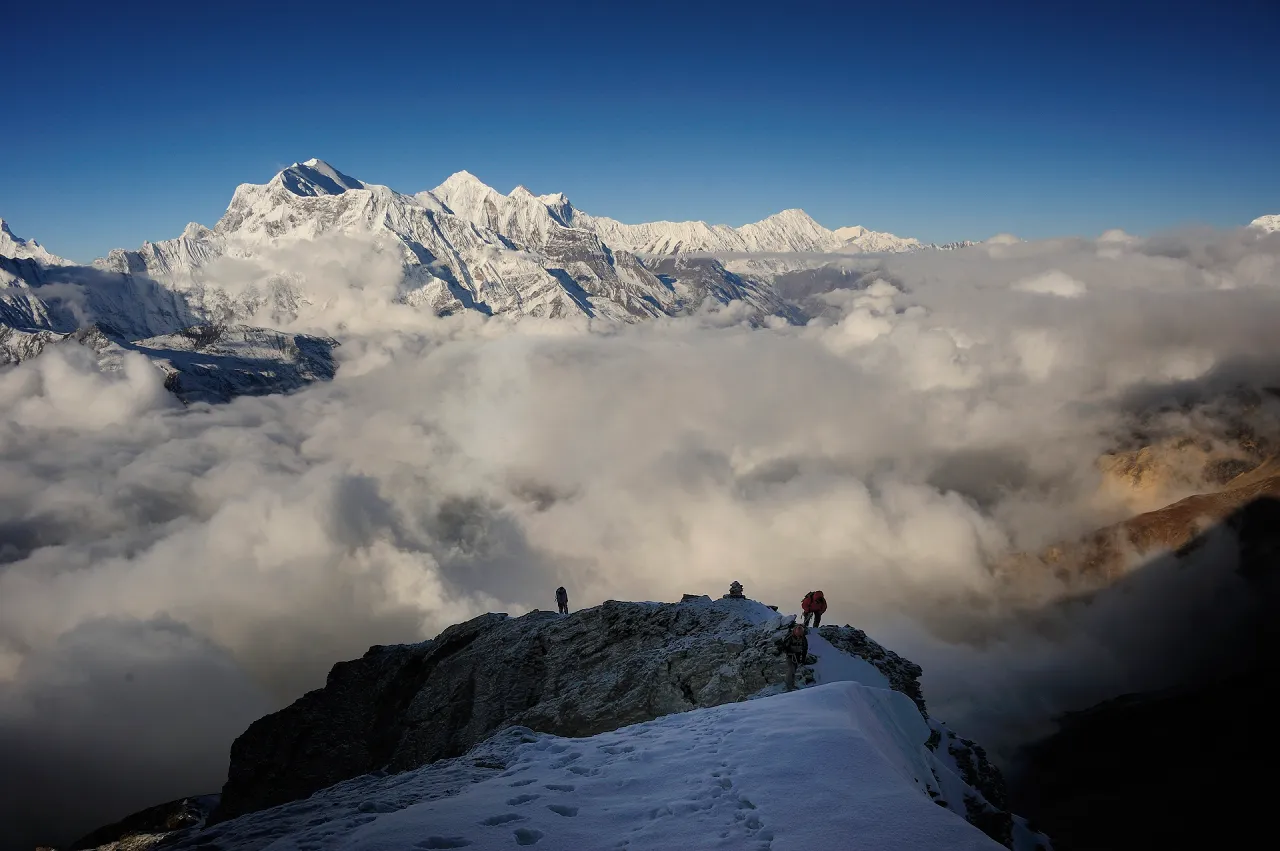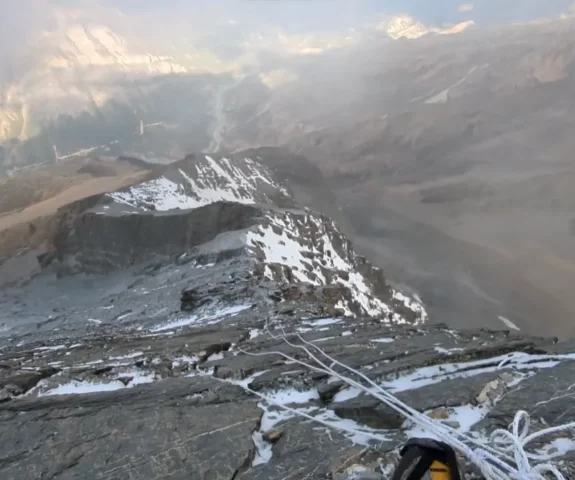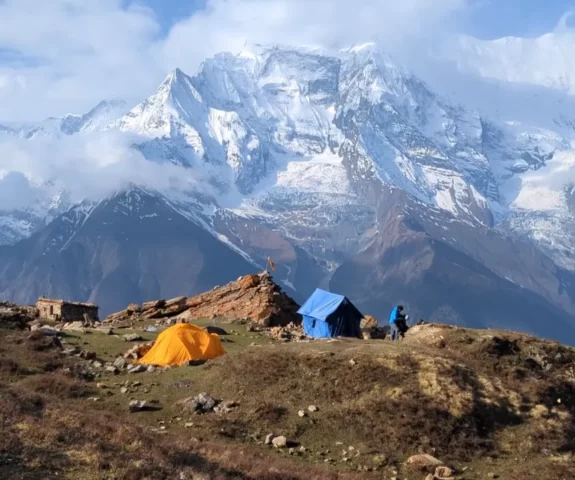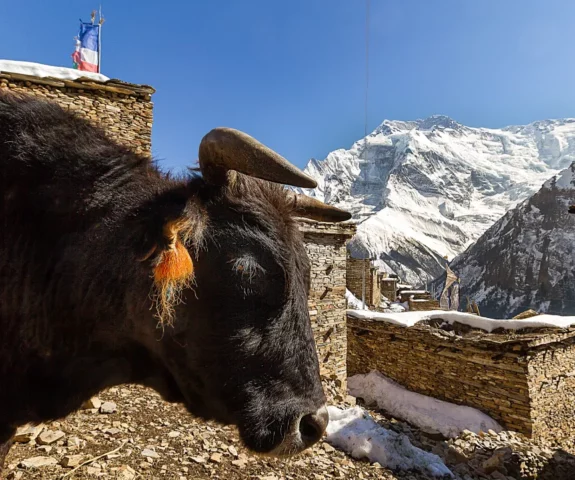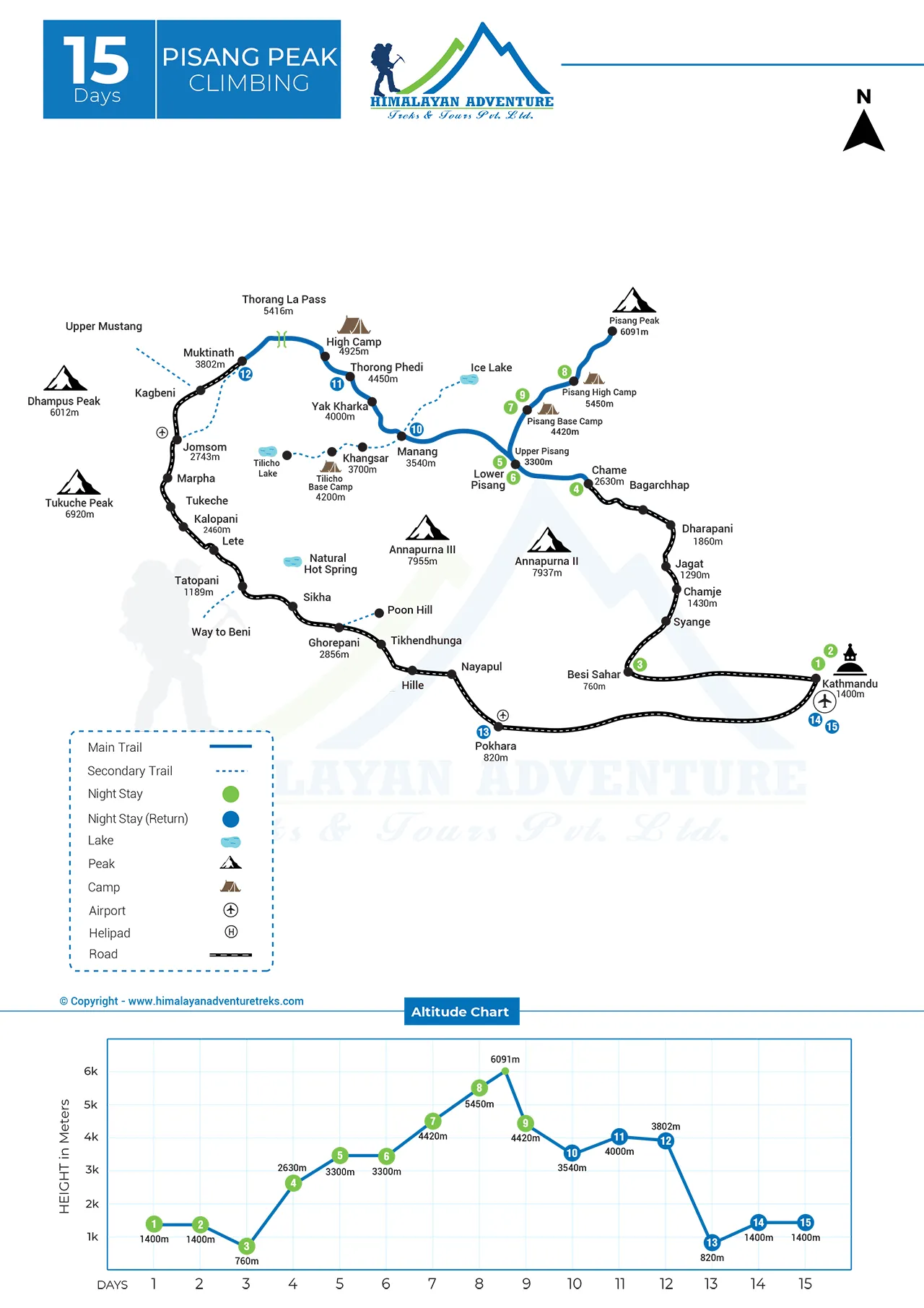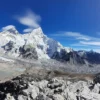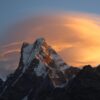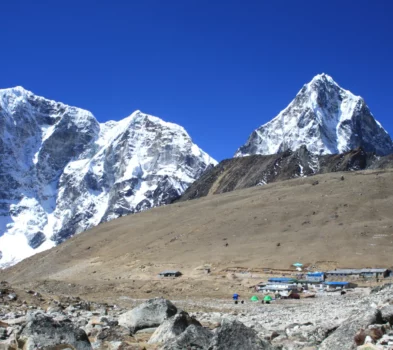Duration
15 DaysPisang Peak Climbing
Trip Grade
ModerateGroup Size
1-16 PeopleMax Altitude
5,400m. / 17,717ft.Best Season
Feb- May/ Sept-NovActivity
Climbing & TrekkingMeals
Breakfast, Lunch & DinnerAccommodation
Hotels, Teahouses & Tented CampTransportation
Private Vehicle, Bus & JeepTrip Customization
On request (click here)Highlights of Pisang Peak Climbing
- An exciting combination of trekking and climbing adventure to conquer the heights of the Pisang Peak
- The up-close visuals of the imposing figures of Gangapurna, Manaslu, Dhaulagiri, Tilicho, Annapurna, and many others
- The challenging and impressive crossing of the Thorong La Pass
- Discover the age-old history of the monasteries
- Explore the diversity of nature and the ethnic groups of Nepal
- Experience the sacredness of Muktinath
- An invigorating experience in Kathmandu and Pokhara
Trip Introduction
If the Himalayas have long been intriguing you and you have an eternal quest to conquer new heights, then take on the challenge of our Pisang Peak climbing expedition that will take you to the new heights of 6091 m elevation. Between spectacular landscapes and a sporting challenge, this 15-day Pisang Peak climbing journey remains one of our greatest adventures.
Overshadowed by the huge frames of Annapurna I (8091 m) and Manaslu (8163 m), the Pisang Peak is located on the very famous Annapurna Circuit trekking trail in the Manang Valley. Regardless of being overshadowed, the peak still offers a unique experience for all mountain lovers across the globe.
First reached in 1955 by Juergen Wellenkamp and his German expedition team, the Peak still remains one of the less frequented in comparison to its Khumbu counterparts. However, very few knew this remarkable Pisang peak climbing with Annapurna circuit journey actually can be a genuine chance for a real escape to the heart of breathtaking landscapes, from green forests to snow-capped peaks.
Our Pisang peak climbing itinerary spans for 15 days that begins with your road journey from Kathmandu to Besi Sahar, which will continue till you reach Chame. Your exciting hiking adventure then begins which will carry you forward towards Upper Pisang and then to Pisang Base Camp that elevates to 4380 m.
You will then proceed to the 5400 m High Camp from where you will assault the summit the next day. Once you are at the Peak, you will have the complete encompassing visual of Ganesh Himal (7422 m), Tilicho Peak (7134 m), Manaslu, East Chulu (6584 m), Kuchubhro Peak (5910 m), Gyaji Kang (7038 m), Kang Guru (6701 m), and Annapurna.
Now, the second phase of the Pisang peak climbing itinerary starts, that will take you further down towards the Manang Valley. Next challenge awaits you in the journey in the form of 5416 m high Thorong La Pass which will then transition you to Mustang Valley.
Traversing the sacred soil of Muktinath, you will travel back to Pokhara and then head to Kathmandu, bringing an end to your astounding adventure of the Pisang Peak climbing journey.
That is not all, during the trekking and climbing part, you will have the fantastic opportunity to connect with a variety of ethnic groups of Nepal, such as the courageous Sherpas, the lively Tamangs and Magars, and the melodious Gurungs.
You will travel through the stunning variety of ecosystems and landscapes from the lush forest to the path lined with sacred Mani Walls, from the Martian-like lands to the majestic alpine glacial Universe.
In short, our Pisang peak climbing with the Annapurna circuit includes all the essential elements that define an exciting and comprehensive adventure.
Reaching Pisang Peak is a challenge accessible to any motivated trekkers and climbers. With an ascent that can be achieved in just a few days, it is the ideal opportunity to live an adventure off the beaten track, while discovering one of the most beautiful mountains in the Annapurna range.
Outline Itinerary of Pisang Peak Climbing
Day 01: Arrival at Kathmandu Airport.
Day 02: Kathmandu Valley Sightseeing and trip Preparation..
Day 03: Drive from Kathmandu to Besisahar (823 m).
Day 04: Drive from Besisahar to Chame (2675m).
Day 05: Trek from Chame to Upper Pisang (3,700 m).
Day 06: Acclimatization Day in Upper Pisang (3,700 m).
Day 07: Trek from Upper Pisang to Pisang Peak Base Camp (4,380 m).
Day 08: Trek from Pisang Peak Base Camp to High Camp (5,400 m).
Day 09: Summit Pisang Peak (6,091 m) & Return to Base Camp (4,380 m).
Day 10: Trek from Pisang Peak Base Camp to Manang Valley (3,450 m).
Day 11: Trek from Manang to Throng Phedi (4,420 m).
Day 12: Trek from Thorong Phedi via Thorong-La Pass (5,416 m) to Muktinath (3,800 m).
Day 13: Drive from Muktinath to Pokhara (825 m).
Day 14: Drive from Pokhara to Kathmandu.
Day 15: Departure to Kathmandu Airport.
Our guests sharing their experiences (Photo/Video Gallery)
Detail itinerary of Pisang Peak Climbing
Day 01: Arrival at Kathmandu Airport.
Prepare to be embraced by the lovely Kathmandu- the gateway to your Pisang Peak climbing adventure. As you exit the TIA arrival gate, you will fond our local staff holding our agency name.
After you are being assisted with the luggage, he will take you to your Kathmandu lodging we have selected for your comfortable stay. If you have arrived early, you can spend the day resting or exploring the nearby attractions.
Once all our climbers are in Kathmandu, our guide will meet with the group and will explain about our Pisang peak climbing itinerary. We will have the whole day tomorrow for capital excursion and trip preparation so you will be at your leisure time today.
Activity: Airport Pickup, 30 min
Max. Altitude: 1,400m/4,593ft. Kathmandu
Accommodation: Hotel
Day 02: Kathmandu Valley Sightseeing and trip Preparation..
On the second day of your adventure, you will explore the mesmerizing city of Kathmandu. This important metropolis is deep in history and culture and is home to some of the most significant UNESCO protected landmarks such as Pashupatinath temple, the serene Boudhanath Stupa, the historic Kathmandu Durbar Square, and the iconic Swayambhunath.
Today, we will explore each of these remarkable landmarks, and once we are finished with our touring, we will then gear up for the exciting journey that lies ahead.
Activity: Sightseeing, 5-6 hours
Max. Altitude: 1,400m/4,593ft. Kathmandu
Meal: Breakfast
Accommodation: Hotel
Day 03: Drive from Kathmandu to Besisahar (823 m).
Early in the morning, we will take a tourist bus and get ready to leave Kathmandu. The busy traffic-laden Kathmandu road will lead us out through Kalanki and Thankot.
Soon, we will be surrounded by the fresh air coming through the rolling green hills as we start to travel along the comfortable and beautiful Prithvi Highway.
The marvelous current of Trishuli River can be seen below while the Lamjung, Annapurna, and Langtang Peaks will grace the horizon. For a while we will be following the route to Pokhara, but once we pass by Dumre, we will diverge our route to north and see the wide crystal waters of Marshyangdi River guiding us to Besi Sahar- an administrative headquarter of Lamjung.
Activity: Drive, 5-6 hours
Max. Altitude: 823m/2,700ft. Besisahar
Meal: Breakfast, Lunch & Dinner
Accommodation: Teahouse
Day 04: Drive from Besisahar to Chame (2675m).
From Besi Sahar, we will enjoy a local jeep ride and travel onward through Bhulbhule and Ngadi. Our track will ascend for a while leading us to Bahundanda placed on the crest of the lovely green hill.
We will then descend to Syangje Village nestled beside the Marsyangdi River. The road will rise again towards Jagat from where the bending road will lead us to Chamje.
We will now drive through the stunning location of the Manang region. The upcoming track can be a bit strenuous with some sharp and rocky segments but completely manageable by the jeep.
Driving through Tal, and Karte, we will find ourselves in the lively Gurung settlement known as Dharapani. Our journey will once more ascend us to the 2160 m elevated Bagarchhap Village, the first settlement that truly displays the extraordinary architecture of Tibetan culture.
Driving through Danakyu,Timang, Lata Marang, and Koto, we ill finally be at Chame – the administrative headquarter of the Manang region where we can feel and breathe in the pure cool air flowing through Annapurna II and Lamjung Peaks.
Activity: Drive, 6-7 hours
Max. Altitude: 2,675m/8,776ft. Chame
Meal: Breakfast, Lunch & Dinner
Accommodation: Teahouse
Day 05: Trek from Chame to Upper Pisang (3,700 m).
Finally, the trekking segment of our Pisang Peak climbing itinerary commences from today with a gentle and easy path leading us up to Upper Pisang Village. The route from Chame takes the north turn along the shore of the Marshyangdi River following the cool shade o the pine forest.
With mild elevation gain, we will continue on and arrive at the orchard village of Bhratang. From here, we will keep on proceeding along a moderately challenging trail to a bridge.
After the bridge crossing, the trail will take a steep turn taking us to the ridge of Dhukur Pokhari. Marveling at the picturesque view of Pisang Peak to the north and Chulu peak, we will take on a moderate one hour climb to lower Pisang.
Upper Pisang is now only an hour climb away from here where we will be spending the first night after our trekking adventure. We can later explore its charming setting and riverside areas.
Activity: Trek, 5-6 hours
Max. Altitude: 3,700m/12,139ft. Upper Pisang
Meal: Breakfast, Lunch & Dinner
Accommodation: Teahouse
Day 06: Acclimatization Day in Upper Pisang (3,700 m).
Today, we will take the opportunity to rest and acclimatize so our bodies are well-prepared before we attempt the summit climb. After breakfast, we will take a short visit to the nearby monastery of the village and admire the beautiful outlines of majestic Gangapurna, Annapurna and Tilicho Peaks.
Then, we will gear up ourselves and practice some climbing at nearby ridge which will prepare us for the ascension of the peak and also boost our confidence.
Activity: Hike, 3-4 hours
Max. Altitude: 3,700m/12,139ft. Upper Pisang
Meal: Breakfast, Lunch & Dinner
Accommodation: Teahouse
Day 07: Trek from Upper Pisang to Pisang Peak Base Camp (4,380 m).
Today, we will be reaching the highly anticipated base camp of the Pisang Peak. After we leave Upper Pisang, our route will ascend through small forest and meadows leading us to an expansive pastureland known as Kharka elevated at 4380 m.
It is an ideal location for establishing the base camp for the night. This area is located along a well-established trail in a flat alpine zone. Here, we will pitch in our tents and our guide will then give us a brief introduction to technical climbing part of the peak.
Activity: Trek, 4-5 hours
Max. Altitude: 4,380m/14,370ft. Pisang Peak Base Camp
Meal: Breakfast, Lunch & Dinner
Accommodation: Tented Camp
Day 08: Trek from Pisang Peak Base Camp to High Camp (5,400 m).
After dismantling our tents at the base camp, we will now set forth to reach the High Camp of the Pisang Peak elevated at 5400 m. We will rise by around 1000 m by the end of the day so it is necessary that we proceed with caution and at slow pace.
The trail leading up to the High Camp can be enveloped with snow and the route will be narrow, and steep along some rocky sections. However, the Manaslu, Gangapurna, Annapurna, Chulu East, and Tilicho peaks will be shining brightly in the distance which will keep us encouraging to push forward.
Once we are the High Camp, our crew will once again pitch in the camps for us and we will be for one last time practice some climbing session.
Activity: Trek, 7-8 hours
Max. Altitude: 5,400m/17,717ft. High Camp
Meal: Breakfast, Lunch & Dinner
Accommodation: Tented Camp
Day 09: Summit Pisang Peak (6,091 m) & Return to Base Camp (4,380 m).
Finally, the moment has arrived- the biggest day of our Pisang peak climbing with Annapurna circuit. Its time that we assault the summit; so we will rise early even before dawn and set forth to tackle the clearly marked ridge.
There is no such challenge of technical complexity but the inclination of the slope will be around 45 to 50 degrees steep. Therefore, our climbing guide will secure the ropes to facilitate our ascent.
Once at the summit, Ganesh Himal, East Chulu, Manaslu, Tilicho Peak, Kuchubhro Peak, Gyaji Kang, Annapurna, and Kang Guru Peak will warmly embrace us with their stunning profiles.
After a quick photography session, we will now walk back to the High Camp, collect our belongings and tents, and then proceed back to the base camp.
Activity: Summit, 8-9 hours
Max. Altitude: 4,380m/14,370ft. Base Camp
Meal: Breakfast, Lunch & Dinner
Accommodation: Tented Camp
Day 10: Trek from Pisang Peak Base Camp to Manang Valley (3,450 m).
We will leave the base camp in the early morning hours and make our way back to Upper Pisang. Then, we will continue following the route running through the beautiful array of Mani Walls.
We will climb sharply for about an hour and reach the 3670 m high Ghyaru Village. The village is a seemingly a nice spot to enjoy the stunningly attractive features of Tilicho, Gangapurna, Lamjung, Annapurna II, III, and IV mountain Peaks.
Now walking along the relatively gentle flat terrain, we will reach 3657 m elevated Ngawal Village with massive Chulu range standing in front. Now, the trail will take the dramatic turn and take us downstream sharply to Bragha Village (3450 m).
We will take a moment to admire the five hundred years of history of the small monastery that rests in this village. Another 30 minutes journey will now lead us to the Manang Village rich with Tibetan style housings, environment and high and arid hills.
Activity: Trek, 5-6 hours
Max. Altitude: 3,450m/11,319ft. Manang Valley
Meal: Breakfast, Lunch & Dinner
Accommodation: Teahouse
Day 11: Trek from Manang to Throng Phedi (4,420 m).
Once we exit Manang, our journey will take place on the elevated path that will lead us to 3650 m high Tengi Manang. Our ascension will further intensify as we take on the vertical incline trail that will guide us to Ghunsang Village (3890 m).
We will now continue our journey north and keep climbing past several chortens and Mani Walls. Eventually, we will reach the extensive pastureland of Yak Kharka (4120 m).
From here, we will continue our journey to Upper Yak Kharka, and then walk across the highly suspended bridge to reach Chauri Letder. Now, a narrow track beside the calm waters of the Thorong River will guide us along the steep slope toward Thorogn Phedi.
This wide dry land is surrounded by the impressive mountain frames of Khatungkan, Sagang, and Gundang. It will be our cozy settlement before we attempt the massive and most well-known Thorong La Pass.
Activity: Trek, 6-7 hours
Max. Altitude: 4,420m/14,501ft. Throng Phedi
Meal: Breakfast, Lunch & Dinner
Accommodation: Teahouse
Day 12: Trek from Thorong Phedi via Thorong-La Pass (5,416 m) to Muktinath (3,800 m).
Today, we will be reaching the penultimate point of our Pisang peak climbing with the Annapurna circuit trek: the prominent 5416 m Thorong La Pass.
From Phedi, we will take on the demanding climb towards the High Camp of the Pass. Once we conquer that steep climb, the trail ahead will be comfortable enough for us to keep on going till we again encounter the sharp incline for about 2 to 3 hours.
Eventually, the Pass decorated with the multifaceted prayer flags will arrive. Its top is not that narrow and here you can even find a small tea house where you can drink hot tea against the outstanding backdrop of Mukut Himal, Annapurna, Dhaulagiri, and the stunning Kali Gandaki Gorge.
It’s now time that we set off on our lengthy and difficult descent of around 3 hours to reach Muktinath. A sheer drop of 1600 m awaits us after which we will walk beside the impressive Jhong Khola and walk past Ekle Bhatti and Khinga to reach Muktinath.
The Village has a main temple shrine where Buddhists and Hindus gather to pray for their eternal liberation. The eternal flame and the 108 magically beautiful natural water springs are the major attractions of the temple complex.
Activity: Trek, 7-8 hours
Max. Altitude: 3,800m/12,467ft. Muktinath
Meal: Breakfast, Lunch & Dinner
Accommodation: Teahouse
Day 13: Drive from Muktinath to Pokhara (825 m).
The days of trekking and climbing have finally come to an end, and now it’s time to drive from Muktinath to Pokhara. Our bus will take us down along the twisting mountain road passing through the charming locales of Ranipauwa, Jharkot, Jhongg, and Kagbeni.
The dramatic transformation of the landscape will no doubt captivate our senses while the striking outlines of Tukuche, Dhaulagiri, and Nilgiri seem to be even more magnificent.
As we approach Lupra, the road becomes smoother, guiding us toward Jomsom. Now, the nicely built tarmac road of the Beni-Jomsom Highway will carry us onward through Tukuche, Kowang, Lete, Dana, and Tatopani, eventually leading us to Beni.
From here, the expansive Beni Road will direct us toward Baglung as we continue our journey along the spectacular Pokhara-Baglung Highway. Along the way, we can enjoy the lively sight of the Kushma Market while we progress towards Pokhara.
Activity: Drive, 7-8 hours
Max. Altitude: 825m/2,707ft. Pokhara
Meal: Breakfast & Lunch
Accommodation: Hotel
Day 14: Drive from Pokhara to Kathmandu.
From Pokhara, the countryside road of the Prithvi Highway will whisk us one more time through the Trishuli River. One more time, we will encounter the heavy road traffic of Thankot and Pokhara before we finally find ourselves in the comfortable setting of our capital accommodation.
A nice pleasant celebratory dinner will give a beautiful ending to our Pisang Peak climbing expedition.
Activity: Drive, 6-7 hours
Max. Altitude: 1,400m/4,593ft. Kathmandu
Meal: Breakfast & Dinner
Accommodation: Hotel
Day 15: Departure to Kathmandu Airport.
You will journey back today to your home leaving Nepal and its Himalayas. Our staff will take you to the TIA departure Gate precisely 3 hours before your designated flight.
We hope we have given you some cherished moments of your life and we have played a part in making your journey enjoyable. Please have a very safe and pleasant journey back home.
Activity: Airport drop, 30 min
Max. Altitude: 1,400m/4,593ft. Kathmandu Airport
Meal: Breakfast
Note:
If you have your own private group and want to make your trip private, we can run the custom trip all the day as per your requirements and group size.
Includes and Excludes
What are included with package?
- Airport pickups and drops in a private vehicle: You will be picked up and dropped off at the airport in a private vehicle, ensuring comfort and convenience for your arrival and departure.
- Three Nights 3-star hotel in Kathmandu with Breakfast: The package includes a stay in a 3-star hotel in Kathmandu for three nights, with daily breakfast included to kickstart your day.
- One Night 3-star hotel in Pokhara with Breakfast: You’ll stay in a 3-star hotel in Pokhara for one night with breakfast included, offering a comfortable base before continuing your trek.
- Kathmandu Sightseeing by private vehicle with an experienced tour guide: You will be guided on a sightseeing tour of Kathmandu, including visits to key landmarks, by an experienced tour guide with transportation provided in a private vehicle.
- Kathmandu/Besisahar/Pokhara/Kathmandu by tourist bus: Travel between Kathmandu, Besisahar, and Pokhara will be arranged via a tourist bus, ensuring a comfortable journey to and from trekking areas.
- Besisahar to Chame by sharing jeep: The transportation from Besisahar to Chame will be by shared jeep, a convenient way to reach the starting point of the trek.
- Teahouse/ Lodges accommodation during the trek: During the trek, accommodation will be provided in teahouses or lodges, offering basic but comfortable facilities along the route.
- An experienced, helpful, and friendly Guide, porters (1 porter for 2 clients): An experienced guide will accompany you throughout the trek to ensure your safety and provide insights. You’ll also have a porter for every two clients to carry your luggage.
- Staff costs include their salary, insurance, equipment, domestic airfare, food, and accommodation: All necessary expenses for the trekking and climbing staff, including salaries, insurance, equipment, domestic flights, food, and accommodations, are covered in the package.
- Tented accommodation during climbing: For climbing portions of the trek, you will have tented accommodations, ensuring you’re well-rested for the challenging days ahead.
- All meals breakfast, lunch, and dinner during the trek and climbing: The package includes all meals (breakfast, lunch, and dinner) during the trek and climbing, providing you with energy for your adventure.
- Drive from Muktinath to Pokhara by bus: After completing the trek, you’ll be driven back from Muktinath to Pokhara by bus, offering a comfortable journey.
- English-speaking, trained, and experienced trekking guide (leader), climbing guide (leader), and assistant guides: The package includes professional English-speaking guides, including a trekking leader, climbing leader, and assistant guides to provide you with expert guidance during the trip.
- Down jacket and sleeping bag (to be returned after trip completion): You’ll be provided with a down jacket and sleeping bag to keep you warm during the trek and climbing, to be returned after the trip is completed.
- All necessary paperwork: All required paperwork, including permits and permissions, will be arranged for you, ensuring smooth entry to trekking and climbing regions.
- Pisang Peak climbing permit: The Pisang Peak climbing permit is included, allowing you to climb the peak as part of the adventure.
- National Park Permit (ACAP): The Annapurna Conservation Area Permit (ACAP) is included to enter the protected park area during the trek.
- Trekkers’ Information Management System (TIMS) Permit: The TIMS permit is included, required for all trekkers to ensure safety and security on the trails.
- Good quality tents and kitchen utensils for camping: During the climbing portion of your journey, high-quality tents and kitchen utensils will be provided for your camping experience.
- Group mountaineering (climbing) equipment: Essential mountaineering and climbing equipment will be provided for the group, ensuring your safety and success during the climb.
- Medical kit (carried by your guide): A first aid medical kit will be carried by your guide to handle any minor injuries or medical issues during the trek.
- All government and local taxes: All applicable taxes, both government and local, are included in the package.
- Last Night’s farewell dinner at an authentic Nepalese restaurant with a cultural performance: To conclude your journey, a farewell dinner will be held at an authentic Nepalese restaurant, accompanied by a cultural performance, providing a memorable end to your adventure.
What are not included with package?
- Nepal Visa fee: You are required to obtain a visa upon arrival at the Kathmandu airport. The visa fee is not included in the package cost.
- International airfare to and from Kathmandu: Your international flights to and from Kathmandu are not covered. You will need to book and pay for your flights separately.
- Entrance fees in Kathmandu: While sightseeing in Kathmandu is included, you will be responsible for paying any entrance fees to specific attractions or temples that may require a separate ticket or fee.
- Travel and rescue insurance: Travel and rescue insurance are not included. It is essential for you to arrange your own travel insurance before the trip, which should cover emergency evacuation and medical emergencies.
- Personal expenses (phone calls, the internet, laundry, bar bills, battery recharge, extra porters, bottle or boiled water, shower, etc.): Any personal expenses such as phone calls, internet usage, laundry services, bar bills, additional porters, bottled or boiled water, and hot showers are at your own expense and not included in the package.
- Optional trips and sightseeing if extended: If you choose to extend your trip for extra sightseeing or tours, these costs will be extra and are not included in the original itinerary.
- Extra night accommodation in Kathmandu and/or Pokhara: If your arrival in Kathmandu is earlier than scheduled, or if your departure is delayed, or if you return earlier than planned due to weather or other reasons, any extra nights of accommodation will be at your own expense.
- Altitude chamber (PAC) or oxygen: If you require the use of an altitude chamber (PAC) or supplemental oxygen during your trek or climb due to altitude sickness, these costs will not be covered in the package and must be arranged at an additional cost.
Pick Your Suitable Date
Book a Private Trip
Private & Group Discount Price
-
1 -
1 person
US$ 4000
-
2 -
2 people
US$ 2500
-
3 -
5 people
US$ 2300
-
6 -
10 people
US$ 2200
-
11 + people
9999
US$ 2000
Total Cost:
US$ 4000
Route Map & Altitude Chart
Kathmandu
Start/End point
Kathmandu
Addon option on Pisang Peak Climbing
We comprehend that each guest is unique and wants to get a different experience on their vacation in Nepal. Some may need a more secluded atmosphere while some may crave to get all the luxury they can get.
Therefore, to accommodate the diverse needs and wishes of each of our clientele, we offer you our add-on option. By utilizing this option, you can enhance your lodging options in the capital of Kathmandu.
With their distinct environment, both cities are the gateways to the wealth of trekking and various other adventures in Nepal. These cities have been proudly serving their guests with various services that are comparable to international standards.
From the modest hostel-like environment to the sophisticated settings of the luxurious accommodations, you name it and they have it all. As for the lavish stays, the five-star hotels here proudly serve their guests with elegant style, decor, architecture, and furnishings along with calm settings, and amenities such as sauna, spa, in-built gyms, pools, and round-the-clock staff services.
However, please understand that upgrading your stay in Kathmandu can incur an added price in your Pisang peak climbing cost. But the additional charge will be quite small, and the service you receive in exchange will be significantly more valuable and worthwhile.
We comprehend that each guest is unique and wants to get a different experience on their vacation in Nepal. Some may need a more secluded atmosphere while some may crave to get all the luxury they can get.
Therefore, to accommodate the diverse needs and wishes of each of our clientele, we offer you our add-on option. By utilizing this option, you can enhance your lodging options in the wonderful city of Pokhara
With their distinct environment, both cities are the gateways to the wealth of trekking and various other adventures in Nepal. These cities have been proudly serving their guests with various services that are comparable to international standards.
From the modest hostel-like environment to the sophisticated settings of the luxurious accommodations, you name it and they have it all. As for the lavish stays, the five-star hotels here proudly serve their guests with elegant style, decor, architecture, and furnishings along with calm settings, and amenities such as sauna, spa, in-built gyms, pools, and round-the-clock staff services.
However, please understand that upgrading your stay in Pokhara can incur an added price in your Pisang peak climbing cost. But the additional charge will be quite small, and the service you receive in exchange will be significantly more valuable and worthwhile.
Your incredible Pisang peak climbing with Annapurna circuit will end as you take the bus from Muktinath to travel back to Pokhara and then onward to Kathmandu.
En route from Muktinath to Pokhara, you will pass through Jomsom which is home to a small domestic airport so you can take a quick 20-minute flight to Pokhara. By selecting this option, you will significantly shorten your travel time on the road.
Similarly, from Pokhara, you have the option to catch an early morning flight to Kathmandu, which will allow you ample time to enjoy your stay in the capital including the opportunity to fly over Everest in a helicopter.
We therefore encourage you to utilize our add-on option and choose to fly either from Jomsom to Pokhara, from Pokhara to Kathmandu, or both so you have a comfortable travel experience.
Please remember though, that selecting the flying option will come at an added minimal cost that is not part of our Pisang peak climbing cost.
Trip Information
Essential Info
Best Time Period for Pisang Peak Climbing
Pisang Peak climbing is a very inviting expedition for both the beginner and the experienced climbers that is open year round. However, every mountaineer and climber wishes to have a successful ascent of the summit.
Therefore, we suggest you the autumn time frame of September, October, and November and the spring time frame of March, April, and June for the Pisang peak climbing with Annapurna circuit trekking journey.
These two intermediary shoulder seasons maximize your chance of a successful push to the summit while enjoying the optimally pleasant climate characterized by mild temperatures revolving around 0 to 17 degrees Celsius.
The driest and most consistent weather, transparent blue sky, and sunny weather ease the travel journey without the threat of severe climactic conditions. The breathtakingly bewitching panorama of the snowy high ridges on the other hand will be an added bonus to your exciting journey.
The winter time frame of December, January, and February also creates a very unique landscape in the Himalayas. The conditions certainly will be harsh with snow covering the base camp, High Camp, the summit, and the Thorong La Pass, but if you are well-prepared, the experience can be very unforgettable.
As an added advantage, there will be fewer climbers en route so you will have the complete tranquility in the midst of the incredible nature.
On the other hand, the monsoon/summer time frame of June, July, and August can be very harsher even for the very seasoned climbers. The relentless rain can dramatically turn the trail very treacherous, especially towards the summit and the Thorong La Pass.
However, if you have an adventurous spirit, Pisang Peak is achievable during this time as well but only with the right equipment and careful planning.
Please remember, we offer this adventure year-round with a strong emphasis on your safety so you can engage in this expedition whenever it suits you best.
Difficulty Level of Pisang peak climbing with Annapurna circuit
The Pisang Peak climbing is regarded as a medium level of alpine climb that is designated as the PD+ in the grading system. The summit however stands out as one of the easy natural climbing peaks in Nepal.
Although devoid of any technical hardships, the last stretch of the summit involves slopes that can reach the inclination of 45 to 50 degrees where the usage of fixed rope must be implemented.
Thus, a little familiarity with using a jumar for the movement along the fixed rope will come in handy. The thick snow along the base camp to the High camp may also necessitate the usage of crampons.
The previous alpine experience or climbing skill is not a requirement but it is certainly beneficial. However, excellent physical fitness is a requirement as reaching the High Camp (5400 m) and then ultimately to the summit can be very demanding.
Fortunately, no advanced technical skills are obligatory, and our expert climbing guide will offer you the training and support for your successful attack on the summit.
On the other hand, the Annapurna circuit trek is also a medium trekking experience which consists of a difficult segment of crossing the 5416 m high Thorong La Pass on the way to Muktinath.
The pass is not overly strenuous, but the journey will be very extensive which necessitates from you a great level of endurance and determination.
Adding to all these challenges is the varied nature of the terrain consisting of dense forest, river crossings, rocky tracks to the snowy trails. Plus, the arid condition of the Manang and Mustang will not be that easy either.
You should also be completely ready for the 6 to 7 hours of daily walks on average. And, to top it all, the AMS will also increase the challenge of this expedition.
Who can attempt Pisang Peak Climbing?
Pisang Peak truly is one of the most accessible trekking Himalayan summits in Nepal making it an ideal choice for all climbers of different calibers and skill levels.
Since the journey to the summit mainly involves trekking, with only a small portion requiring actual climbing, the summit is available for both new and experienced mountaineers.
A high level of technical skills is not necessary however familiarity with moving along fixed ropes is essential. Our climbing guide will provide this training during your time at the base camp and high camp.
He will also keep an eye on your progress and offer assistance whenever needed. However, it’s important to remember that this is a Himalayan peak extending above 6,000 meters, where unforeseen challenges can arise at any moment.
You should be mindful of the altitude of the summit, base camp, and high camp. Additionally, the Thorong La pass presents its own difficulty which is not technical but can be quite strenuous.
Therefore, we recommend that you undergo some training in rock climbing and familiarize yourself with basic mountaineering techniques. We also suggest you first complete the Annapurna Circuit trek to gain practical experience with high-altitude trekking before attempting the summit of Pisang Peak.
AMS (Acute Mountain Sickness/ Altitude Sickness) and Acclimatization
The chance of encountering altitude sickness during our Pisang Peak climbing expedition is undeniably significant. As you progress further into the journey, you will also keep on gaining elevation which means diminishing the content of oxygen in the air.
Once you cross the 5000 m mark, the oxygen concentration will be reduced by almost 50 percent compared to sea level. Therefore, adaptation to the less oxygen air of the Himalayas is very important.
Our carefully thought-out Pisang peak climbing itinerary includes plenty of time for your acclimatization. For example, you will have an acclimatization day in Upper Pisang, followed by a gentle trek of just 3 to 4 hours from Upper Pisang to the base camp and then to High Camp before making your final ascent.
However, some climbers may take a longer time to adjust to the altitude and may display symptoms of Acute Mountain Sickness (AMS) such as headaches, dizziness, fatigue, and loss of appetite, which are generally mild and subside within two to three days.
In order to inhibit the risk of AMS, we advise all our climbers to maintain a fluid balance and stay away from smoking and alcohol. We like to remind you that our guides in the expedition are equipped with an oximeter and first aid kit to monitor your health before, during, and after the ascent.
Our guide also has decades of experience and are well trained in crisis management so you can fully trust their knowledge. If you experience any of the aforementioned signs, please tell our guide and after assessing your condition, he may descend you or postpone your adventure for a few days.
Additionally, you may also use Diamox to help you acclimatize safely to higher altitudes. But make sure to consult with your doctor first to ensure there are no contraindications.
Preparation and Training for Pisang peak climbing with the Annapurna circuit
Our Pisang Peak climbing journey combines both the trekking part and the climbing part. So to prepare yourself for the hiking segment of the adventure, you should commit yourself to the active mode of life.
You can begin with the cardiovascular routine then progress on to building strength and then endurance. Start with simple routines such as walking and cycling that will improve your cardiovascular health.
Then, you can integrate lunges, squats, and planks to develop strength in your upper body and legs. Since there will be the challenge of the high altitude at the High Camp, summit and then Thorong La Pass, it is essential that you gain some practical knowledge through hiking journeys in your home town.
To prepare for the climbing portion of your expedition, you can undertake the Annapurna circuit trek first or the EBC trek first. You should also train yourself in rock climbing and learn basic mountaineering skills which will certainly will serve you well.
Practice walking on crampons and moving along fixed ropes to enhance your skills. If you prefer a more easy peak, then consider climbing an easier peak like Mera Peak before tackling Pisang Peak.
Alternate Route
The normal approach to the Pisang peak is from its northern ridge which is simpler and offers a higher chance of success at the top. There is one more route available from its southwest ridge but it is more avalanche prone and very risky.
If in the middle of the expedition, you think climbing the summit is not appealing to you, then, you can stay at Pisang Peak Base Camp which is also a fantastic option to not only watch but also feel the Himalayas very near to you.
Or, you can take the easier path and skip the trek to Thorong La Pass and instead return directly to Chame from the Pisang Peak base camp. After that, you can just hop in and drive back to Kathmandu. This option will definitely lighten your load.
Alternately, you can also engage in the Annapurna Circuit trek only, bypassing the peak entirely. For an even more thrilling experience, you can also think about including the Tilicho Lake trek in your plans.
Pisang Peak vs the Trekking Peaks of Everest Region (Island, Mera, and Lobuche)
Situated between the majestic giants of Manaslu and Annapurna I, Pisang Peak is one of the most approachable trekking peaks in the Annapurna region.
From the summit, you can admire the stunning close-range panorama of the entire Annapurna mountain range along with the Dhaulagiri range. The route leading to Pisang Peak traverses the well-established and comfortable Annapurna Circuit trek that allows climbers to merge a few other adventurous travel programs in their journey.
On the other hand, the three peaks of Island, Mera, and Lobuche are adjacent summits situated in the scenic location of the Khumbu region of Nepal.
From the tops of these peaks, the visuals are incredibly spellbinding from the visuals of Everest, and Makalu to numerous other mountains in the Everest region. The trails to these summits also follow the most popular trekking paths in Nepal, the Everest trail.
When we compare the difficulty levels of Pisang Peak with the peaks in the Everest region, Pisang Peak is somewhat more challenging than Mera Peak, but it is easier than the other two peaks.
The ascent to Pisang Peak is characterized by a gradual and consistent elevation gain while there will be a more abrupt increase in altitude when compared to its Everest counterparts. The journey to the three Everest peaks begins in Lukla, where climbers have to face a rapid rise in altitude.
In terms of scenic beauty and landscape, the Pisang Peak climbing itinerary provides a more lush and varied experience than the three peaks of Everest.
The Everest trail mainly journeys through the dry and desolate Khumbu region, while the Pisang Peak route starts with the lush and rich landscapes of the Annapurna trail. Then, it transitions to the arid areas of Manang and Mustang before concluding the journey back to Pokhara.
So which peak to attempt first is entirely based on your personal preferences. If you are drawn to the majesty of Everest, it should be any one of the three peaks of the Everest region. But, if the allure of Annapurna captivates you, then Pisang Peak should be your selection.
Accommodation and Dining
When you find yourself in Kathmandu and Pokhara, we promise you a comfortable and pleasant stay in one of the finest three-star hotels with breakfast awaiting you each morning.
Your arrangement will be in a twin room containing two single beds shared among guests with a lone trekker or climber to be paired with another climber of the same gender.
Please also explore our add-on options if you seek more privacy and luxury accommodation for your overnight experience. As your trekking journey begins, you will get to experience unique overnight stays at the local mountain lodges en route.
They also offer basic rooms with double single beds and if you prefer a single bed, you can also request one at an added cost. The comfort of the local lodges may not be very high but you will appreciate them for a single night stay in the high mountains.
Most of the shelters offer their guests mattresses, electric blankets, and cushions along with hot water for showers. WiFi is also accessible now but again at an added fee. At both base camp and high camp, you will be accommodated in high-quality tents, complete with essential kitchen items.
A delightful breakfast in Kathmandu and Pokhara will be a part of our service while throughout your trekking and climbing adventures, we will well feed you with breakfast, lunch, and dinner.
At the tea houses, you can explore classic Nepali Dal Bhat Tarkari, as well as noodles, burgers, pizzas, and toast. During the camping experience, our kitchen team will serve you freshly cooked hot meals three times a day.
Transportation
You will have a private transportation service to pick you up and then smoothly drop you off at TIA at the beginning and end of your journey respectively.
Our Pisang peak climbing cost also includes a special excursion tour of Kathmandu conducted in a private vehicle in the company of an experienced tour guide.
From Kathmandu, you will have a pleasant ride on a tourist bus to Besisahar, followed by a local shared jeep to Chame, where your trekking adventure begins.
On your return, a local bus will take you from Muktinath to Pokhara, and then a tourist bus will again bring you back to Kathmandu. Please also check our add-on options for an enhanced travel experience.
Travel Insurance
Although insurance is one of the least exciting things you may think of, it is indispensable for any climbing expedition in Nepal. We will require a copy of your insurance policy when we proceed to obtain the necessary permits for Pisang Peak climbing in Kathmandu.
Travel insurance is also required for your safety in terms of both illness and finances on your trip. Climbing and trekking are such extreme physical activities where, despite experienced tour guides and all kinds of safety measures, there is a risk of injury.
Whether you have a minor scratch, an insect bite, altitude sickness, or a broken arm, your travel insurance will cover the costs of your treatment. Furthermore, the bacterial composition in Asia is a bit different. Even if you have received vaccines from home, you risk encountering some unpleasant bacteria that can put an end to your incredible adventure!
With travel insurance, you are covered if you need hospitalization or medication to recover from an infection. If you travel without travel insurance, you are gambling with your finances and your safety if something goes wrong.
You could end up with a trip that is completely ruined because you are left without the opportunity to get the help and support you need to continue your trip. Travel insurance is a safe place to save money because you could end up losing a lot of money by not taking out travel insurance.
We suggest you ensure that your travel insurance policy covers lost luggage, lost travel days, hospital stays, medication, medical treatment, medical transport, ambulance transport, medical escort, and legal aid.
It should also cover cover repatriation, and emergency assistance in the event of natural disasters, a major accident, or the like.
Permits for the Pisang peak climbing with Annapurna circuit
To ascend the Pisang summit, it is important to obtain three specific permits. The first is the ACAP permit, which supports the Annapurna Conservation Area Project. The second is the TIMS Card which is the Trekkers Information Management System.
Lastly, you will need the Pisang Peak Climbing Permit, which can be acquired from the Department of Tourism in Nepal. The fees for the climbing permit vary depending on the season: in the high spring season, the cost is 250 USD per person; in autumn, it’s 125 USD; and for winter and summer climbs, it’s only 70 USD per person.
Additionally, the TIMS Card costs 2000 NPR, while the ACAP permit is 3000 NPR. We will be seeing all the expenses and the permit procurement process for you.
Essential Gear List for Pisang Peak Climbing
Nepal is a central location for climbing the high Himalayas; after all, the country boasts 8000 m high Himalayas along with numerous 7000 m and 6000 m beautiful peaks that every climber wants to try at least once.
Pisang Peak Climbing requires a lot of skill, quick decision-making, and presence of mind, but the climbing expedition also needs quality and the right equipment to succeed.
The Himalayan weather is unpredictable as it is, and you have to understand that the weather and conditions can be very different at the base camp and at the summit.
We want you to be very prepared for any peaks that you like to face; that’s why here, we have highlighted the essential items from climbing gear to clothing that you should pack for this challenging expedition to Pisang Peak.
- Your Passport
- Visa
- Passport Photo
- Emergency Contacts
- Local Currency
- Credit or Debit Cards
- Booking Information
- Health Insurance
- Backpack of 45 to 60 L capacity
- Secondary ultralight backpack for daily walking
- Documents Bag
- Toiletry Bag
- Backpack cover
A variety of clothing items are necessary for the Himalayas can at one time give you sunny days, and next, you will be climbing Pisang Peak through a windy and cold climate. Our suggestions include the following:
- Short-sleeved, quick-dry dry and fit T-shirts
- Long-sleeved quick-dry T-shirts
- Cotton T-shirt for the night
- Fleeces for warmth
- Waterproof windbreaker jackets for the winds, rain, and snow
- Down Jacket suitable for temperatures down to -20 degrees Celsius
- Thermal Tops
- Leggings or skin pants
- Thermal pants
- Trekking Pants
- Fleece Pants
- Shorts
- Underwear/Panties, Boxers, Briefs
- Sports Bra
- Sweatpants or pyjamas for the night
- Regular long socks for daily hikes
- Base layer socks for wearing under thick socks
- Thicker, long woolen and cotton socks
- Thick fleece hat
- Cap
- Scarf
- Warm Woolen Gloves
- Thin thermal gloves
- Trekking Boots (high ankle and already worn)
- Sandals and flip-flops for the accommodation
- Sneakers
- Sleeping bag rated for -35 to -40 degrees Celsius
- Sleeping Bag liner (fleece)
- Trekking poles (height adjustable)
- Headlamp and flashlight
- GPS
- Sun Glasses with UV Filter
- Crampons
- Helmet
- Harness for climbing
- Ice axe
- Compass
- Carabiners
- Slings
- Descender: Belayer, Figure 8
- Face Mask
- Ascender: Jumar
- Rope
- Gaiters
- Ice Screw
- Shovel
- Snow Bar
- Tent
- Climbing Boots
- Water Bottle
- Altimeter Watch
- Cell Foam Mats
- Shampoo (very little, as you will be showering only a few times when climbing)
- Wet Wipes (for nonshower days)
- Soap
- Lip Balm
- Moisturizer (for both face and body)
- Toothbrush
- Toothpaste
- Dental Floss
- Body Talcum Powder
- Small and large microfiber towels
- Toilet Paper
- Sanitary Pads
- Phone with charger, headphones, memory cards
- Camera with replacement battery, memory cards, and charger
- Notebook computer, tablet
- GPS or GPS Watch
- Universal Adapter
- Power Bank
- Solar Charger
- Antiseptics
- Painkillers such as Aspirin or Ibuprofen
- Bandages
- Tweezers
- Thermometer
- Disposable gloves
- Your prescribed medications
- Common medicines for diarrhea, nausea, and vomiting
- Anti-allergic medications
- Moleskin or blister pads
- Altitude sickness medication (Diamox)
- Eye and ear drops
- Safety Pins
- Gause Pads
- Scissors
- Water Purification Tablets
- Padlocks
- Head torch
- Multipurpose knife
- Lighter or matches
- Whistle
- Thermal Blanket
- Flashlight
- Compass
- Mosquito spray or repellent
- Water Filter
- National Flag (to show your patriotism once you conquer the summit)
- Water Filter
- Binoculars
- Diary
- Books
- Snacks (dried fruit, salty snacks, chocolate, energy bars, etc.)
Equipment Note:
- Please note that some of the gear, such as sleeping bags, duffel bags of up to 75 L capacity, down jackets, and tents with kitchen utensils, will be supplied by Himalayan Adventure Treks
- A duffle bag, a sleeping bag, and a down jacket must be returned once you arrive back in Kathmandu after completing the expedition.
- Also, most of the climbing gear and other necessary equipment are available for rent or purchase in Kathmandu. So, please do not stress out about bringing the heavy luggage for your journey.
- All the main luggage and climbing gear with tents and kitchen utensils will be transported by our strong porters.
- Once the climbing expedition is complete, we will also provide you with the trip completion certificate as a memento of your peak conquer in Nepal.
Frequently Asked Questions
Can you specify the Pisang peak climbing cost?
Climbing Pisang Peak generally costs around USD 3000 per climber, but this price can vary depending on the size of the group you decide to join.
Is there any age criteria to ascend Pisang Peak?
There are no specific age limits for ascending Pisang Peak except for children of course. If you are fit both physically and mentally, and have some background in high-altitude trekking, then, no doubt, this peak is within your reach.
How much time will it take to climb the Pisang summit?
From the High Camp, you can expect 4 to 5 hours to kiss the summit of Pisang Peak.
How many days will it take to reach the summit of Pisang Peak?
A minimum of 15 days is needed for the safe journey to Pisang Peak.
Is climbing training necessary for Pisang peak climbing with the Annapurna circuit?
Your climbing journey will be smoother if you come with some training on using fixed ropes, jumars, and crampons.
What is the location of Pisang Peak?
Pisang Peak lies en route to the world-famous Annapurna circuit trek that towers the sky of the Pisang and the Manang Villages.
Can I have a private Pisang peak climbing itinerary?
Yes, however, you will need to reserve our private climb for this purpose. When you select a private climb, we will be able to design a more personalized itinerary exclusively for you. Please remember private climb will cost you USD 4000 and you are not allowed the independent climb of the summit. You must reserve the climb through a government-registered travel company like ours.
Can I remain connected during the Pisang Peak climbing trail?
You can maintain a smooth connection through the cellular networks of Ncell or NTC when walking the route of the Annapurna circuit. However, there can be a signal drop when you are at the base and the High Camp of the Peak.
Do I have to have my own tent for the camping arrangements at the base and High Camps?
No, we will be providing you the high quality cold-resistant durable tents for the camping part of the journey.
Which month will be the most comfortable one to attempt the Pisang Peak climbing?
April and October will grant you the most consistent weather pattern for the ascension of the Pisang Peak.
What will happen if I can't reach the Pisang summit on the planned day?
If you can’t make it to the summit because of health issues, you will have to stay at High Camp or Base Camp until the others come back. The next day, if you feel better, you can talk to your group, our guide, and our representative in Kathmandu about the possibility of trying for the summit again. If all agree, you can go for it, however, if your health isn’t improving, you can always try the summit on your next adventure. Remember, Pisang Peak will always be there, ready to embrace you whenever you return.

